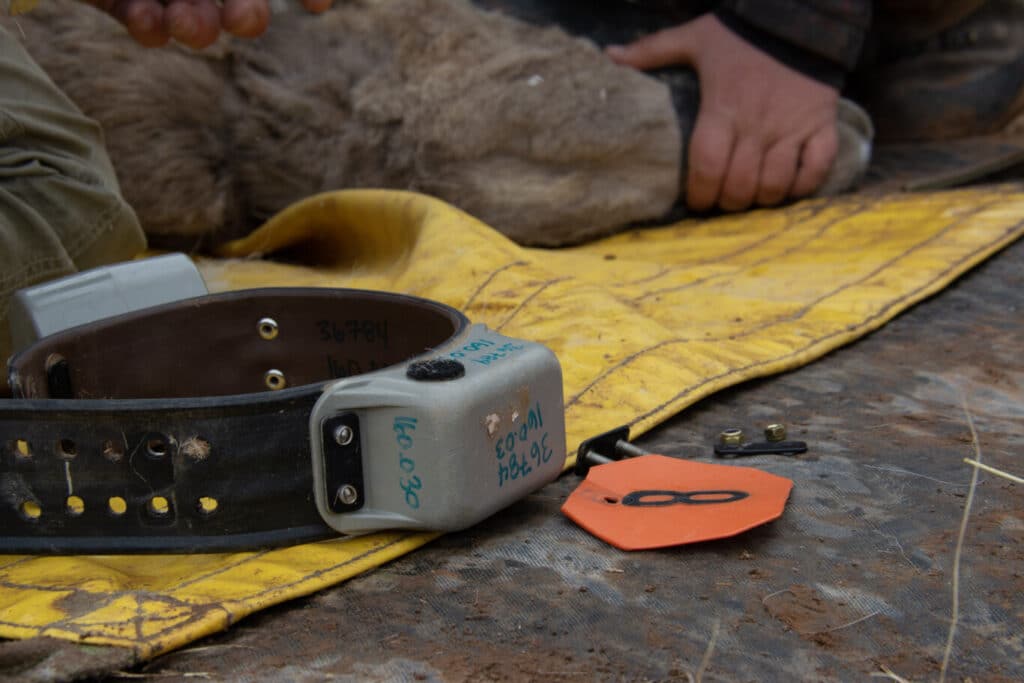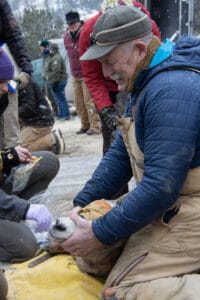Steve Kilpatrick was a habitat biologist for over 30 years before becoming executive director of the Wyoming Wild Sheep Foundation. His experience with wild sheep, understanding Wyoming’s ecosystem, and the issues that plague wildlife and wild places in Wyoming make him incredibly valuable to conservation. That’s why WWF jumped at the opportunity to sit down with Steve and get the low-down the state of wild bighorn sheep in Wyoming.
Steve Kilpatrick’s passion for wild sheep comes from his perspective of bighorns being the “canary in the mine” for wild landscapes. Steve, a longtime biologist says, “If we can keep sheep alive, we can keep a lot of other species happy, too!” Though bighorns look big and strong on the precipices where they live, their populations are quite susceptible to disease and habitat issues.
Though there’s no hard estimated figure, Wyoming had close to 100,000 sheep in the state before the Lewis and Clark Expedition. By 1960, the herd was down to 25,000 sheep. Then it was brought to over 6,500 in 2017 from millions of dollars of restoration funding and hours of volunteer time. Kilpatrick says the sheep are back in decline these past few years, though, losing between 15 and 20% of the population rather quickly. We are now down to only 5,000 – 5,500 bighorns, 5% of our historic numbers.
The real question remains – why are wild sheep numbers within Wyoming’s largest core native herd declining all of a sudden. This core native herd, which essentially ranges from Dubois to Cody and includes approximately 4,000 sheep. The reason for its decline is unknown, but likely it’s a multitude of reasons lead by disease.
This core population is also the largest metapopulation of bighorn sheep in the lower-48 nowadays. It also is just across the street to the north from the historic Whiskey Basin herd. In the ’90s, Whiskey Basin went through a significant pathogen-related die off. The population, which once numbered over 2,000 wild sheep and is now down to 500 or less, provided 1,700 sheep for transplantation across the west. Researchers are currently studying the causes, and lethal pneumonia-related pathogens resulting in elevated lamb mortalities is presently the known limiting factor. The University of Wyoming study will continue through 2021.

There is a suite of pathogens that have infected and impacted sheep. Die offs usually occur when pathogens work in combination. One of the most prevalent pathogens involved in die-offs is Mycoplasma ovipneumoniae, also known as “M. Ovi,” which debilitates the cilia in the lungs and sets up a lethal strike from another pathogen. Scientists do not believe wild sheep were historically exposed to these pathogens. The science is undoubtedly imperfect from the inability to look backward in time to determine all wild sheep deaths pre-European contact. However, researchers have concluded that these pathogens were brought to wild bighorn sheep populations through agriculture – namely domestic sheep.
Currently, wildlife managers do know the best way to keep wild sheep from contracting most of these non-native pathogens is simply through the separation of the two species. One of the things the Wyoming Wild Sheep Foundation and other organizations have done is work with sheep producers on public lands grazing allotments to offer economic incentives to alter livestock practices. Often, that looks like trading from grazing domestic sheep to cattle. Over a dozen producers have done just that while taking a financial benefit since 2000.
The Wyoming Wild Sheep Foundation, domestic sheep producers, and other partners have had tremendous success. Currently, none of the core native bighorn sheep herds in Wyoming have domestic sheep grazing on the public land allotments within the herd. And, the vast majority of the domestic sheep producers remain in the agriculture business. While the domestic sheep industry has seen over a 50% decline in numbers since the late 1990s, only 3-5% of that decline can be attributed to allotment buyouts. A “win’ for both sides.
“Every one of these allotments was purchased with fair market dollars, and no one is forced to do anything – everyone is willing,” adds Kilpatrick. Owners of these allotments also ask their peers if other livestock producers wanted those allotments.
One of the most urgent issues the Wyoming Wild Sheep Foundation is working on includes potential bighorn sheep and domestic sheep interaction in the Owl Creek Drainage sheep – a part of the core native herd between Cody and Dubios. There is a livestock producer on privately owned land who includes domestic sheep in their business portfolio. However, that poses a major disease threat to the largest metapopulation of bighorns in the lower 48.
Much of Steve and the Wyoming Wild Sheep Foundation’s efforts lately focus on the Owl Creek situation. Steve says, “we just want to work with the landowner to figure out some way to maintain separation between the species – – do what we can so we can keep those domestic sheep from coming in close contact or overlapping with bighorn sheep.” “ We have been working hard to find compromises that maintain a healthy wild sheep herd and make sure the livestock producer’s family, livelihood, culture, and business are kept intact and doing well. However, we do not feel we have the resources to meet the current request of a $5M 3-way land trade and annual domestic sheep feeding expense of $250,000 per year while we work on the land trade. We are dealing with a private property right vs. a public wildlife icon issue – not simple.”

Photo | Jess Johnson
It’s not all doom and gloom for sheep in Wyoming, though. New lamb survival had been low in the Ferris/Seminoe Mountain Range in the mid-2000s. Biologists then transplanted earlier-lambing bighorns from Devil’s Canyon from the west side of the Bighorns and found a solution to the problem.
As it turns out, the earlier lambing cycles of these newly transplanted bighorn sheep better match forage phenology, leading to better body condition, lactation, and higher survival rates. These early lambing sheep in the Ferris range have been doing much better. Recent habitat analysis indicates excellent opportunities for increased wild sheep numbers with plenty of high-quality sheep habitat for that herd to thrive.
The Wyoming Wild Sheep Foundation, wildlife agencies, public land managers, and other NGO’s are all working together to protect, conserve, and improve bighorn sheep populations in Wyoming. They are currently developing a “herd unit – by – herd unit plan forward,” which will identify strategies and actions to conserve Wyoming’s bighorns into the future. Without collaboration and the support of members and donors, the work would not be possible.
If you want to get involved more with Wyoming wild sheep conservation, feel free to visit www.wyomingwildsheep.org
The Instagram Live Show between the Wyoming Wildlife Federation and Steve Kilpatrick of the Wyoming Wild Sheep Foundation on May 26, 2020, informed the writing of this article. Some facts may have changed by the time you have read it.
